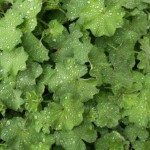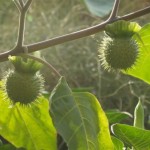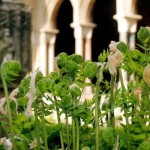 |
 |
 |
Above, from left to right: lady’s mantle (Alchemilla mollis) in Cuxa Cloister; downy thornapple (Datura metel) in Bonnefont Garden; fiddleheads of the royal fern (Osmunda regalis) in Trie Cloister. All photographs by the author, Barbara Bell.
There is a garden tool that may not be in your shed, but it’s one that I use frequently: a camera. It’s handy to take photos of plant labels when I visit botanical gardens, and it helps me keep a visual record of the plants and planting combinations that pique my interest.
People often ask me how they can take better pictures of plants and gardens. There are many factors to consider, but the one that likely will provide the biggest impact is lighting. I’ve heard that some plant photographers will not venture out unless the skies are overcast; like portrait photography, most plant subjects look best under diffused, soft light. There are no harsh shadows or high-contrast conditions when shooting under a cloudy sky. It also seems quite natural to see a plant dappled with raindrops in these lighting conditions. Sometimes, when nature has not obliged, I use a spray bottle to provide droplets. Colors seem more vibrant and saturated on a cloudy day, as you can see in the photo of Alchemilla mollis, above.
There are always exceptions to the rule, and the world would be very dull if every picture looked as if it had been shot under a soft box in a studio. There are plants that, like certain movie stars of the 1940s, show their best features under a strong key light, sharp focus, and crisp shadows. Atmosphere is what we are creating here. Perennial grasses, large-veined foliage, fuzzy and spiky edges are all more dramatic when photographed with the sun behind them.
Usually, it is best to shoot a back-lighted subject in the early morning or late afternoon, when the sun is close to the horizon. If you find it necessary to bounce a little light back onto the front of your subject, either use a fill flash or a reflective card just out of the camera???s range but tilted toward your subject. In the photo of the Datura above, a slash of sunlight emphasizes the plant’s menacing nature.
Another way to create a stunning photo is to use depth of field to your advantage. A camera that has adjustable f-stops or film speed will permit you to photograph the subject in close range with the background out of focus. This creates a sense of depth, and in the case of the image of the fiddleheads above, it reveals a sense of place, which is Trie Garden at The Cloisters. If your camera only allows you to select shutter speeds, pick the fastest one to shorten the depth of field so your background will be in softer focus.
Finally, get down on the plant???s level. How often have I seen people taking pictures of children and plants from many feet above? Plants will not crane their necks to look up at you, so don’t be afraid to lie down on the path or the lawn. Sometimes you can even get away with just kneeling.
???Barbara Bell
Tags: Alchemilla mollis, Datura, fiddleheads, photography

June 13, 2009 at 10:00 pm
Difused light does wonders for mosiac glass as well, which can be found in gardens as part of the outside decor. It usually makes the piece much more reflective and therefore lively.
June 15, 2009 at 3:42 pm
Yes, Tiffany, glass does reproduce very well under soft light, too. One of the unique challenges is trying not to capture the camera’s image in the reflective pieces. An exercise we did in photo class back in college was to look for the photographer in reflective subjects in magazine ads!
July 7, 2009 at 3:18 pm
Barbara,
Great information! I’d love to read more about plant photography in the future.
July 7, 2009 at 8:10 pm
Thank you, Kim. In the meantime, you might like to look for the work of Karl Blossfeldt whose photographs of seed pods and flowers were used as teaching aids in his design classes at Berlin’s Arts and Crafts School. They are lovely to look at and are in a book titled “Karl Blossfeldt”, published by Taschen in 2005. Also search the Met’s image archive for the green pepper photographs by Edward Weston, great examples of how lighting can elevate a subject to another realm.
August 17, 2009 at 1:46 pm
Good informations about plant photography. Hopeful to get more informations on future about this subject.Nice considering the camera as a tool needed for a garden and it’s true helps you get new ideas and improve your garden
August 17, 2009 at 3:07 pm
Merci, plantesjardinsnature! One of the garden chores that could be taken care of now is planning for autumn planting. Reviewing the photo library on my computer and looking at bulb catalogs are two activities perfect for a 93 degree Fahrenheit afternoon.
September 22, 2009 at 7:38 pm
Barbara, it was wonderful to meet you today at the Cloisters and it is doubly wonderful to discover your very helpful photographic advice. The photographs give clear evidence of its soundness; they are beautiful and technically admirable. And who else would note the way water beads on ornamental plants? Thank you!
September 23, 2009 at 4:09 pm
So often when I am in the Cloisters’ gardens visitors say that it must be such a pleasure to work here. My immediate reply is always an affirmation. Besides working outdoors with the plants, one of the other pleasures is meeting the visitors, and seeing the gardens through their eyes. Thank you, too!